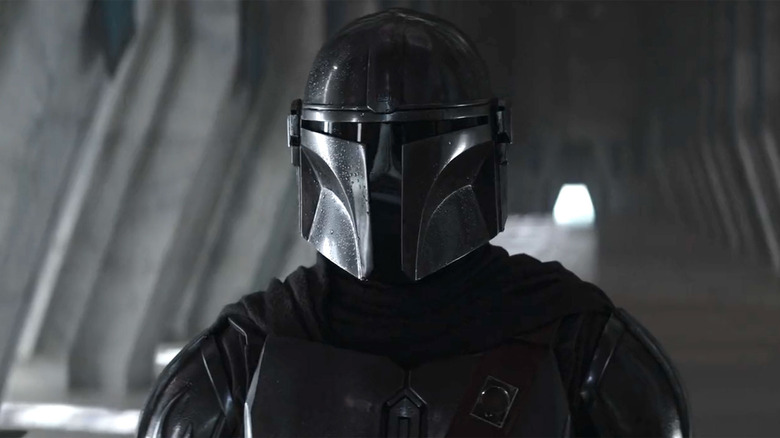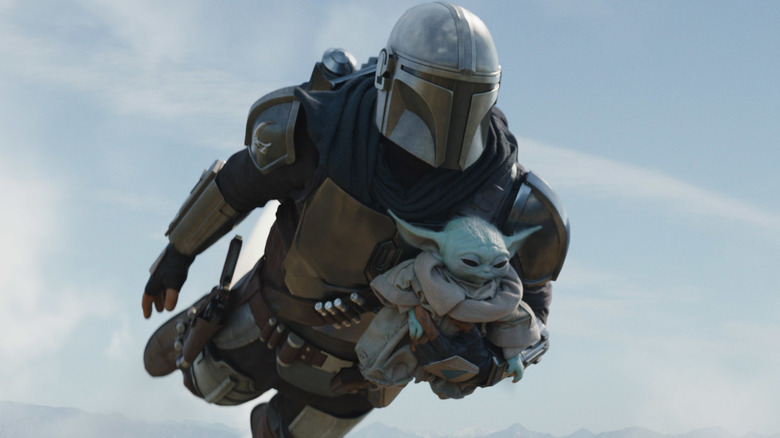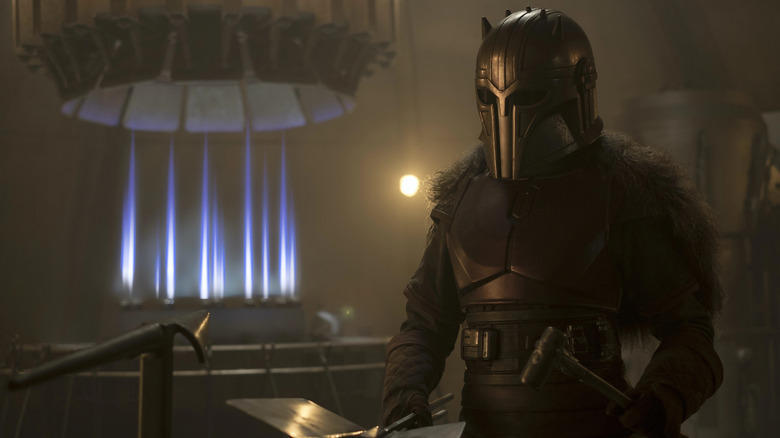Pedro Pascal Can't See Anything With His Mandalorian Helmet On
In season 3 of "The Mandalorian," the age-old debate shall continue: helmet on or off? Din Djarin (Pedro Pascal) spent most of his life staying true to the strict rules of his clan and making sure no other living being would ever see his face. But one adopted child and a complete upheaval of his life later, that rule has officially been broken. He even let baby Grogu touch his face in the season 2 finale! Adorable as that sounds, some see breaking the creed of his clan as an unforgivable act. Others are a lot less concerned about who has seen Din's face and way more concerned about why the helmet is so darn heavy.
The man in question is, of course, Pedro Pascal, who told Empire Magazine that wearing Din's Beskar outfit is "like putting on a head-to-toe glove with weights on it." Which is to say that despite the extra weight, it fits him perfectly. For Pascal, the importance of Din's armor is so much bigger than just keeping him safe from (oh so many) enemies. It allows him to fully embrace the character. Pascal explained, "When it's on, you immediately feel powerful, protected, dangerous, and like a protector."
That being said, he did note one very distinct caveat: once the helmet is on, the rest of the world disappears. Pascal said, "It's ironic that you can't see any facial expression because it puts you in the world so completely, and instantly makes the character feel real — but you can't see s**t!"
Yes, the tragedy of the Mandalorian helmet is a two-way street. Not only is the audience robbed of the opportunity to lay eyes on Pedro Pascal's face — the poor guy can't see a dang thing once he's in costume.
A bold fashion statement or a dangerous hindrance?
Though the changes aren't always visible to the audience, Mando's armor has undergone quite a few upgrades over the years. As Pedro Pascal told Empire, "They've continued to finesse and make it more comfortable." But the trickiest aspect of all has remained the same and to this day, donning the iconic helmed is "like going blind." That visor window that makes Din so immediately intimidating to strangers, and keeps his face from being perceived? It's absolutely badass! But it's also wildly impractical. Pascal explained, "Your breath completely fogs up the narrow slit that you can see through. There's no peripheral vision."
In other words: "If there's a hole, I'm gonna fall into it."
Typically, oversized costumes or characters wearing vision restrictive heads are given an assigned handler and helper, like the kind, polo-clad helpers often hovering near Mickey Mouse at Disney World, but that's not exactly possible when shooting a series like "The Mandalorian." This means that the mighty Din Djarin — the same guy who might very well be key to the future of Mandalore — can be easily defeated by trapdoors, holes, bear traps, and the like. Nobody tell his (many) enemies! Though if worse comes to worst, Grogu could likely handle Force maneuvering his Papa out of any stray holes, that is, if Pascal can stop sobbing while looking at the adorable face of his beloved companion.
The Armorer also can't see
Emily Swallow, who plays The Armorer, also struggles with her helmet, as she told /Film during an interview the most difficult part of playing a character in this universe is "not tripping over everything." Swallow said that during the first season of the show, the characters had to spend time "trying to find the language of communication for any of the Mandalorians who were helmeted." Luckily, now that the show is on its third season, the team has found a way to interact with one another and convey intent and emotions without the luxury of facial expressions.
"It's honestly been such a great journey for me that goes beyond just trying to communicate as the character," Swallow said. "I have found that in understanding the language for her, it winds up being a tremendous lesson for me in trust, just overall because what I have realized is that simplicity serves her so well." The simplicity is definitely part of the success and intrigue of "The Mandalorian." Without a face to connect to, the audience has to be enticed and kept entertained in other ways. For the actors, it forces them all a bit out of their comfort zones.
"I knew what it looked like, and I could see that this beautiful costume that I was wearing conveyed a very specific idea, but it felt incredibly awkward in there," said Swallow. "And there was this feeling of, 'Wait, but do you know what I'm trying to tell you?'" While the actor's intent may be well thought out, knowing if the intention has been properly expressed when communicating with another character donning a helmet also with limited visibility is no easy feat.
Fortunately, "The Mandalorian" continues to be must-see television for "Star Wars" fans, regardless if the cast can see one another.


